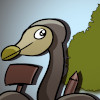Volcanoes in Mauritius
The little island of Mauritius was formed when a big shield volcano erupted some 10 million years ago during the Pliocene period. It is believed that Mauritius was created by three main volcanic eruptions (The Ancient Series, The Early Series and the Recent Series) interspaced by calm periods. These series of volcanic activities gave rise to the number of mountains, gorges and valleys that can be seen all over the island. The ranges of Port Louis - Moka and some scattered isolated mountains are believed to be the leftover (walls of the caldera) of the huge volcano that initially created Mauritius. The last volcanic eruptions are thought to have been during the last 600, 000 to 700,000 B.P. and involved mainly about 20 volcanoes found along the North-North-East and South-South-West axis of the island; the last volcanic eruption can be dated to about 20,000 years ago by the L’escalier crater at Nouvelle Decouverte. There are four main famous volcanoes in Mauritius that are thought to have been active during the past 700,000 years: Trou aux cerfs, Trou Kanaka, Bassin Blanc and Grand Bassin.
Trou aux cerfs, the spitting image of a perfect volcano, is found on the central plateau of the island in Curepipe. It is a monogenetic volcano with a central vent; it has a diameter of 350m at the surface and a crater that is about 80m deep. It is easily accessible and offers a breathtaking view of the island and sometimes when the weather is clear, the coast of the island of La Reunion can even be seen. The crater acts as a catchment area where the Grand River North West and the Tatamaka rivers have their sources.
Grand Bassin also called Ganga Talao by the Hindu population of the island is a beautiful volcano whose crater has been replaced by a natural lake, the water of which is considered as sacred by the Hindus. Located in Savanne, the volcano is at 1800 feet above sea level, irregular in shape and sound techniques have revealed the depth to be about 55-60 feet deep. It offers a beautiful view of the forests bordering the rims of the volcano and is a common place for prayers today.
Basin Blanc is found further south and is a type of funnel shaped crater about half a mile in diameter that is filled with water. Here again, the borders are rich in plants and trees and it is a great place to view some endemic birds of Mauritius such as white tailed tropic bird, Mauritius bulbul, Mauritius cuckoo shrike etc. Trou Kanaka is also found in the south of the island and resembles a true volcano in shape with shrubs bordering the rims up into the crater.
Other volcanoes with true craters on the island are Verdun Hill, Trou Raoul, Curepipe Point, Bois Cheri, Butte Chaumon, Bar le Duc, L’escalier, Mt Piton and Forbach Hill. Some of the volcanic cones without craters are Mt Virer, Buttes aux Papayes, The Mount, Mt William, Calebasses, Mt Alma, Malherbe, Tamarin Estate, Trou de Mme Bouchet, Mt Perruche and Les Mares.


